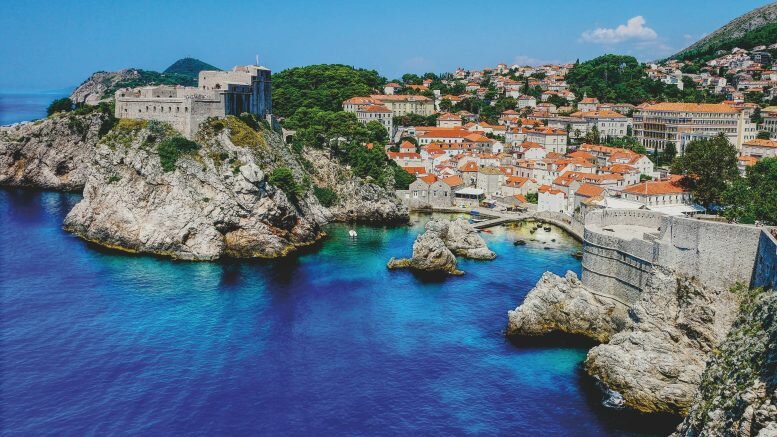Come the summer holidays, many northerners are eager to swap the North Sea for the Mediterranean. Read on to find out why it’s popular to visit Croatia from Norway – and how to find a good dose of kos down south, too.
From natural wonders and cultural heritage protected by UNESCO to Michelin-starred Adriatic eats and world-renowned wine, Croatia is a no-brainer for any avid globetrotter.
It comes as no surprise, then, that adventure-loving Norwegians love to visit Croatia from Norway – especially during the spirited, sun-soaked Croatian summertime.
We’re bringing you the top five reasons why travel from stunning Scandinavia to the awe-inspiring Adriatic is all the rage.
1. Basking on sun-drenched beaches
Sun is certainly a summertime staple in both Norway and Croatia. In Northern Norway the midnight sun, and in Southern Norway almost 20 hours of daylight per day, are the summer norm.
Meanwhile, Croatia’s coastline is the sunniest on the Adriatic and among the sunniest in the world. For avid koselig seekers – the perfect replacement for your mug of hot chocolate is a glass of chilled Croatian wine; and for a warm fireplace, the Adriatic sunshine.
Summer temperatures in Croatia can easily surpass 30 degrees Celsius and they rarely fall far below 20. The country’s sea temperatures average in the mid-20s Celsius during summertime.
Croatia’s shoreline is as beautiful – and diverse – as it is warm. Gracing Croatia’s northernmost coastline is the Istrian peninsula where pristine beaches mingle with Roman ruins and medieval architecture.
Each of Croatia’s 1000 islands is unique in its own right. Pag Island features a moon-like terrain with the rocky beaches to match.
Brač Island features one of the Croatian coast’s loveliest sand beaches.
Further south, many beaches are backed by the Biokovo mountain range.
Those are just a few of Croatia’s beachy hotspots – endless hidden coves and untouched beaches wait to be discovered (road trip down the coast, anyone?).
2. Savoring local specialties
Croatia is just as famous for its cuisine as its coastline with seven Michelin-starred restaurants, dozens of Michelin-recommended eateries, hundreds of wineries (many of which are award-winning), and overall world-renowned cuisine.
Like in Norway, seafood plays a central part in Croatia’s gastronomic scene – but with a totally different take. Croatia’s gastro maestros traditionally prepare freshly caught seafood (everything from fish and scampi to oysters and octopus) on the grill with a blanket of local olive oil and herbs such as rosemary and sage.
The heartiness of Croatia’s specialties helps Norwegians feel right at home while trying out novel flavors, too. Must-try dishes include cheesy dough dish štrukli, homemade sausages, and beef stew with vegetable čorba in continental Croatia, while lamb or octopus cooked pod pekom (under a bell-shaped lid warmed by hot coals) shouldn’t be missed in Dalmatia.
Wine is an art in vineyard-filled Croatia – which is ideal for Norwegians who have rare opportunities to taste wine almost right off the vine at home. A glass (or bottle) of homemade Plavac Mali is every oenophile’s dream.
3. Taking in Croatian culture, heritage, and traditions
Both countries home to great literary, musical, and creative figures, Norway and Croatia have mutual respect for the arts.
Inhabited continuously since around 800,000 BC (dated for a Stone Age tool found in a cave near the city of Pula), Croatia has a long, rich history. From the world’s largest Neanderthal community in northern Croatia to ancient civilizations like the Vučedol Culture that boomed in eastern Croatia around 2500 BC, across major Roman centers and Slavic migrations, to Venetian and Hapsburg rule… Croatia’s heritage is abundant.
And it’s got the amazing architecture to prove it.
Croatian literature began to flourish during the Renaissance and continues to bloom today. Monumental tributes to Croatia’s renowned literary figures can be found across the country.
Norwegians and Croatians also have a mutual understanding of the struggle for independence. The Croatian War of Independence lasted from 1991-1995 and is a subject of multiple museums in the country.
Like in Norway, museums are the pride of Croatia – whose capital city of Zagreb is said to have the most museums per capita on Earth. Along with classical museums home to renowned international and local artists (such as Ivan Meštrović), Zagreb features quirky newcomers like the Museum of Hangovers and Museum of Broken Relationships – both the first of their kind in the world.
17 Croatian inclusions have also been listed as UNESCO-protected Intangible Cultural Heritage, including the art of dry stone walling (seen throughout Dalmatia), klapa singing (usually carried out by male acapella groups), the Mediterranean diet (for multiple countries), kolo (a traditional folk dance usually done in costume), and old-school lacemaking.
A more unofficial – but absolutely crucial – Croatian tradition is… Relaxing over coffee.
Coffee culture is well and alive in Croatia where never-empty cafes adorn every street corner – luckily for Norwegians, who also love their caffeine fix!
Having coffee with friends is how Croats blow off steam – and it’s not uncommon for coffee dates to last hours – eventually turning into drinks and maybe even a night of partying.
Croatia’s got something to suit almost every taste – from underground techno hubs and live indie gigs to mass music festivals and even a club-filled stretch of coastline dubbed “the Croatian Ibiza”.
4. No-sweat traveling
It’s a piece of cake traveling from Norway to Croatia. Distance – around 1750 kilometers by air and around 2300 by road, to be exact – causes no issues.
One-stop flights from Norway to Croatia are readily available, especially from Oslo to Zagreb. You can be in Croatia from Norway in as little as five hours via airplane.
Train and bus routes (with stops) also connect the two countries and generally last at least 30 hours. Road trip lovers can take a ferry from Norway to Denmark and continue to Croatia by car or motorcycle for a non-stop journey of around 25 hours.
There is a Norwegian embassy in Zagreb, as well as honorary Norwegian consulates in Dubrovnik and Rijeka. Croatia has an embassy in Oslo, as well.
5. Going toe to toe with the great Croatian outdoors
Another thing Norway and Croatia have in common is surreal nature.
Outdoors-loving Norwegians will have no shortage of activities to do across Croatia’s eight national parks and 11 nature parks (in fact, over 10% of Croatian land is protected).
Sports activities in Croatia are unlimited: one can scuba dive alongside corals, kayak to ancient fortresses,
bike through vineyards and olive groves, hike mountains inhabited by brown bears, raft down turquoise rivers,
windsurf (especially in the Windsurfing World Championship-hosting village of Viganj), play tennis (and also watch it at the ATP Croatia Open Umag)… and much more.
Another reason Norwegians flock to Croatia during the summertime is to get their fix of the stars, moon, and Milky Way – which, during Norway’s bright summer, is generally impossible. Likewise, striking sunsets and sunrises are also a draw of Croatia.
And so, we’ve scratched the surface of the many reasons why Norwegians choose Croatia as their go-to summer destination.
Dig deeper and discover even more of the country’s charms and partake in Croatian-style with a visit yourself.
Source: Norway Today





Be the first to comment on "Find your kos in Croatia: A guide for traveling from the North Sea to the Mediterranean"